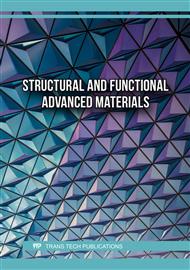[1]
Chandrathilaka, E. R. K., Baduge, S. K., Mendis, P., &Thilakarathna, P. S. M. (2021, December). Structural applications of synthetic fibre reinforced cementitious composites: A review on material properties, fire behaviour, durability and structural performance. In Structures (Vol. 34, pp.550-574). Elsevier.
DOI: 10.1016/j.istruc.2021.07.090
Google Scholar
[2]
Lau, K. T., Hung, P. Y., Zhu, M. H., &Hui, D. (2018). Properties of natural fibre composites for structural engineering applications. Composites Part B: Engineering, 136, 222-233.
DOI: 10.1016/j.compositesb.2017.10.038
Google Scholar
[3]
Reddy, P. V., Reddy, R. S., Rao, J. L., Krishnudu, D. M., & Prasad, P. R. (2021). An overview on natural fiber reinforced composites for structural and non-structural applications. Materials Today: Proceedings, 45, 6210-6215.
DOI: 10.1016/j.matpr.2020.10.523
Google Scholar
[4]
Sullins, T., Pillay, S., Komus, A., &Ning, H. (2017). Hemp fiber reinforced polypropylene composites: The effects of material treatments. Composites Part B: Engineering, 114, 15-22.
DOI: 10.1016/j.compositesb.2017.02.001
Google Scholar
[5]
Singh, H., Singh, J. I. P., Singh, S., Dhawan, V., & Tiwari, S. K. (2018). A brief review of jute fibre and its composites. Materials Today: Proceedings, 5(14), 28427-28437.
DOI: 10.1016/j.matpr.2018.10.129
Google Scholar
[6]
Kim, J. T., & Netravali, A. N. (2010). Mercerization of sisal fibers: effect of tension on mechanical properties of sisal fiber and fiber-reinforced composites. Composites Part A: Applied science and manufacturing, 41(9), 1245-1252.
DOI: 10.1016/j.compositesa.2010.05.007
Google Scholar
[7]
Adeniyi, A. G., Onifade, D. V., Ighalo, J. O., &Adeoye, A. S. (2019). A review of coir fiber reinforced polymer composites. Composites Part B: Engineering, 176, 107305.
DOI: 10.1016/j.compositesb.2019.107305
Google Scholar
[8]
Muhammad, A., Rahman, M., Hamdan, S., & Sanaullah, K. (2019). Recent developments in bamboo fiber-based composites: a review. Polymer bulletin, 76(5), 2655-2682.
DOI: 10.1007/s00289-018-2493-9
Google Scholar
[9]
Venkateshwaran, N., & Elayaperumal, A. (2010). Banana fiber reinforced polymer composites-a review. Journal of Reinforced Plastics and Composites, 29(15), 2387-2396.
DOI: 10.1177/0731684409360578
Google Scholar
[10]
Khosla, P. K., Pal, R. N., Negi, S. S., &Kaushal, P. S. (1982). Genetic evaluation of nutritional parameters in leaf fodder species-GrewiaoptivaBurrett. In Improvement of forest biomass: symposium proceedings/edited by PK Khosla. Solan, India: Indian Society of Tree Scientists, c1982.
Google Scholar
[11]
Kumar, R. R., Chauhan, J., & Joshi, U. Social Economical and Medicinal Importance of Grewiaoptiva.
Google Scholar
[12]
Singh, C., & Singh, R. (2019). Grewiaoptiva (Drumm. Ex Burr)-a multi-purpose tree under agroforestry in sub-tropical region of western Himalaya. Journal of Tree Sciences, 37(2), 36-43.
DOI: 10.5958/2455-7129.2018.00015.8
Google Scholar
[13]
Rana, A. K., Potluri, P., & Thakur, V. K. (2021). Cellulosic Grewia optiva fibres: towards chemistry, surface engineering and sustainable materials. Journal of Environmental Chemical Engineering, 9(5), 106059.
DOI: 10.1016/j.jece.2021.106059
Google Scholar
[14]
Kumar, S., Patel, V. K., Mer, K. K. S., Gangil, B., Singh, T., &Fekete, G. (2019). Himalayan natural fiber-reinforced epoxy composites: effect of Grewiaoptiva/Bauhinia Vahlii fibers on physico-mechanical and dry sliding wear behaviour. Journal of Natural Fibers.
DOI: 10.1080/15440478.2019.1612814
Google Scholar
[15]
Karakoti, A., Aseer, J. R., Dasan, P. K., & Rajesh, M. (2020). Micro cellulose grewia optiva fiber-reinforced polymer composites: relationship between structural and mechanical properties. Journal of Natural Fibers, 1-12.
DOI: 10.1080/15440478.2020.1800549
Google Scholar
[16]
Singha, A. S., & Thakur, V. K. (2010). Synthesis and characterization of short Grewiaoptiva fiber‐based polymer composites. Polymer Composites, 31(3), 459-470.
DOI: 10.1002/pc.20825
Google Scholar
[17]
Sawpan, M. A., Pickering, K. L., & Fernyhough, A. (2011). Effect of various chemical treatments on the fibre structure and tensile properties of industrial hemp fibres. Composites Part A: Applied Science and Manufacturing, 42(8), 888-895.
DOI: 10.1016/j.compositesa.2011.03.008
Google Scholar
[18]
Noori, A., Lu, Y., Saffari, P., Liu, J., & Ke, J. (2021). The effect of mercerization on thermal and mechanical properties of bamboo fibers as a biocomposite material: A review. Construction and Building Materials, 279, 122519.
DOI: 10.1016/j.conbuildmat.2021.122519
Google Scholar
[19]
Verma, D., & Goh, K. L. (2021). Effect of mercerization/alkali surface treatment of natural fibres and their utilization in polymer composites: Mechanical and morphological studies. Journal of Composites Science, 5(7), 175.
DOI: 10.3390/jcs5070175
Google Scholar
[20]
Hashim, M.Y., Roslan, M.N., Amin, A.M., Zaidi, A. M. A., & Ariffin, S. (2012). Mercerization treatment parameter effect on natural fiber reinforced polymer matrix composite: A brief review. International Journal of Materials and Metallurgical Engineering, 6(8), 784-790.
Google Scholar
[21]
Kumari, Y. R., Ramanaiah, K., Prasad, A. R., Reddy, K. H., Sanaka, S. P., & Prudhvi, A. K. (2021). Experimental investigation of water absorption behaviour of sisal fiber reinforced polyester and sisal fiber reinforced poly lactic acid composites. Materials Today: Proceedings, 44, 935-940.
DOI: 10.1016/j.matpr.2020.11.002
Google Scholar
[22]
Ouarhim, W., Zari, N., & Bouhfid, R. (2019). Mechanical performance of natural fibers–based thermosetting composites. In Mechanical and physical testing of biocomposites, fibre-reinforced composites and hybrid composites (pp.43-60). Woodhead Publishing.
DOI: 10.1016/b978-0-08-102292-4.00003-5
Google Scholar
[23]
Ilyas, R. A., Zuhri, M. Y. M., Aisyah, H. A., Asyraf, M. R. M., Hassan, S. A., Zainudin, E. S., & Sari, N. H. (2022). Natural fiber-reinforced polylactic acid, polylactic acid blends and their composites for advanced applications. Polymers, 14(1), 202
DOI: 10.3390/polym14010202
Google Scholar


